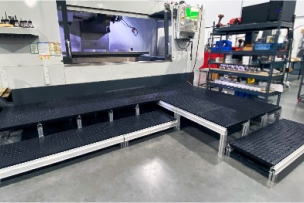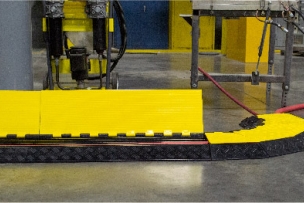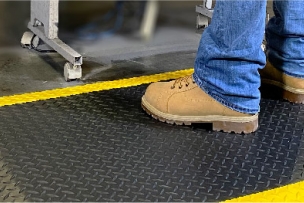By Wearwell team member Dawn Niven
Part I: Workplace slips matter… my story
The college I attended was in a downtown area and, as in most major cities, parking was at a minimum, making the cost of parking a premium, and resulting in long walks to get to the campus. It was located in the north, which included a lot of snow and ice. Add to that equation having to carry lots of stuff, rushing to get to class, and the mind being preoccupied on all of the things a college student has to worry about, and you have an equation for disaster...a slip on the ice.
Which is exactly what I did. Now, besides the fact that it would have been a candidate for America’s Funniest Videos, the incident would not make the news or anything. I caught myself mid-slip and regained my balance. No broken bones or bruises. I even managed to hang on to all of my stuff, which as my arms came back down in position, an extra 30-pounds yanked on every muscle I had. I did not slide by without injury. Two more steps and I realized something was wrong. I turned and headed back home where I proceeded to spend three painful days on the couch, face down, where it hurt to take a breath.
Workplace slips… the data
The National Safety Institute reports that workplace slips and falls do not constitute a primary cause of fatal occupational injuries, but represent the primary cause of lost days from work (or in my case work and school). Additionally, slips are one of the leading causes for workers’ compensation claims, and are on the rise, due to migrating contaminants that are making concrete floors more slippery.
The Occupational Safety and Health Administration (OSHA) has outlined relatively new safety regulations for flooring. Although OSHA’s current standard 1910.22 was published in 1971, there is a provision — 1910.22(a)(2) — that requires employers to maintain floors “in a clean and, so far as possible, dry condition.”
In 2010, OSHA proposed a Walking-Working Surfaces and Personal Protective Equipment rule, which has kept the same language. This proposed rule, according to OSHA, was to prevent slips, trips, falls and other hazards.
“OSHA proposed the rule (75 FR 28862) in 2010, but no final rule has been published,” says an OSHA spokesperson. “The proposal does not require employers to have a qualified person on hand to regularly inspect floors and implement cleaning/maintenance programs. The proposal requires that ‘where hazardous conditions may affect the structural integrity of the walking-working surface, a qualified person must perform or supervise the maintenance or repair of that surface.’”
What if there were invisible factors, not necessarily seen? Concrete and tile floors, and many other surfaces for that matter can be slippery, even when it is not wet. Dust, shoe structure, constant pacing and pivoting can cause a loss of traction when no friction is present. The Occupational Safety and Health Administration (OSHA) and the American with Disabilities Act (ADA) have recommended a coefficient of friction of at least 0.6 to 0.8 on walking and standing surfaces.
Workplace slips… the solution
Matting is a great solution to offer co-efficiency of friction to a surface and prevent workplace slips. The ADA guidelines have no specific requirements for the usage of matting. In many cases, anti-fatigue mats can provide required reasonable accommodation necessary for a disabled worker, aka an industrial athlete, to perform the required job task, but in certain circumstances flooring is a better solution where ramps are available and surfaces that are smooth for wheeled scenarios but still of traction.
Workplace slips… the final word
Everyone has slipped at one time or another. Manufacturing, hospitals, or virtually any type of floor that has heavy or public traffic, can get a build-up of cross contaminants, in addition to their proprietary contaminants such as dirt, oil, water or ice. The best prevention is one that profits in keeping the floors dry and well maintained through:
- Regular cleaning
- Clearing
- Adding elevated gripping surfaces providing traction over inclines and slippery areas
Reduction in the quantity of slips can save thousands of dollars and hours in productivity. The first step is simple–make the floor a priority. Inspection and testing of floors should be part of the routine maintenance in any facility.
Previously Featured on Wearwell's blog.








Talk to Us!
Leave a reply
Your email address will not be published. Required fields are marked *